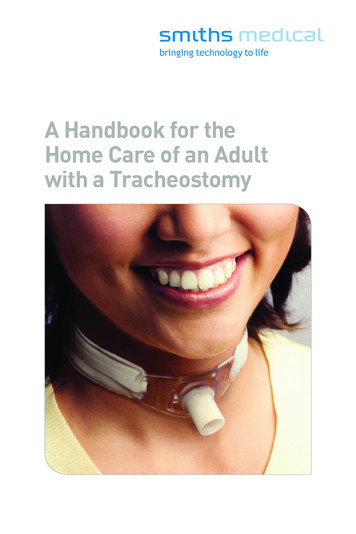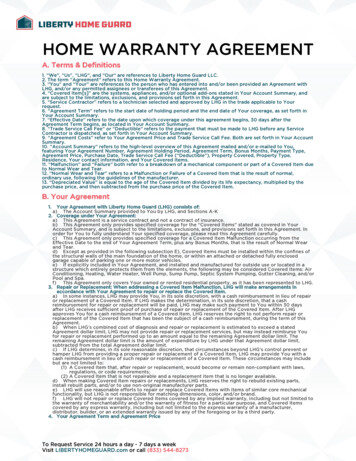
Transcription
A Handbook for theHome Care of an Adultwith a Tracheostomy
Table of ContentsForeword2What Is a Tracheostomy?3Why Does My Loved One Have a Tracheostomy?3How Do We Breathe Normally?3How Does the Respiratory System Work?4What Makes Breathing with a Tracheostomy Different?5Parts of a Tracheostomy Tube7Types of Tracheostomy Tubes8Materials8Sizes8Cuffed and Uncuffed Tubes9Tracheostomy Care10Skin and Stoma Care10Changing the Tracheostomy Ties12Humidification13Loosening and Suctioning of Secretions14Changing the Tracheostomy Tube18Emergency Care Procedure19Special Instructions for All Portex Bivona Tracheostomy Tubes21Bivona Fome-Cuf Tracheostomy Tubes21Bivona TTS (Tight-to-Shaft) Cuffed Tracheostomy Tubes23Bivona Aire-Cuf Tracheostomy Tubes24Cleaning and Reusing Bivona Tracheostomy Tubes24Living with a Tracheostomy26Seeing a Tracheostomy Tube for the First Time26Getting Ready to Come Home26When the World Sees a Tracheostomy Tube27The First 24 Hours Home28One Final Thought29Frequently Asked Questions30Telephone Numbers/Contacts32Glossary33 www.smiths-medical.com 1
ForewordAs a care-giver for a person with a tracheostomy or as a patient yourself,you most likely have many questions and concerns as you prepare to leavethe hospital. We at Smiths Medical hope this booklet will answer many ofthese questions, lessen your concerns, and give you the information thatyou need to properly care for your tracheostomy at home. Many patients,both children and adults, care for their tracheostomies at home. Theyare able to do many of their normal activities such as work, play, school,travel and have family contact.This handbook is meant as a guide for the use and care of Smiths Medicaltracheostomy tubes. It is not meant for use with other brands of tracheostomy products. Also, this handbook is meant to help family and friendslearn how to care for the patients.This handbook is provided as an additional resource only and is notintended as a complete text! You should always follow the specific policies,procedures and recommendations of your doctor. Questions regardingyour care should be directed to your doctor or home health care provider.2 www.smiths-medical.com
What Is a Tracheostomy?A tracheostomy is a small opening through the skin in your neck into thewindpipe (trachea). A small plastic tube, called a tracheostomy tube ortrach tube, is placed through this opening into the trachea to help keepthe airway open. A person breathes directly through this tube, instead ofthrough the mouth and nose.Why Does My Loved OneHave a Tracheostomy?A tracheostomy helps protect the airway andmakes a path through which breathing (ventilation) can be given by a machine (ventilator) ifneeded. It is sometimes needed because there isa block in their breathing passages or becauseillness has caused the airway and lungs toproduce secretions (mucus) which are too thickand can only be cleared with suctioning.How Do We Breathe Normally?Breathing moves air in and out of our lungs. The most important gas in theair that we bring into our bodies is oxygen. The oxygen travels down ourairway into the lungs where it goes into small air sacs (alveoli). Here oxygentravels through a very thin wall that separates the blood from the air. Oncein the blood, the oxygen travels all the way through our body and is usedas an important fuel to produce energy. As oxygen is used up, it makes awaste product, carbon dioxide (CO2). We get rid of CO2 as we breathe out.www.smiths-medical.com 3
How Does the Respiratory System Work?As we breathe in, the large muscle (diaphragm) that divides the chestfrom the stomach, drops down and the rib cage gets bigger, and then theair flows into the lungs. Air enters the nose, which warms, filters and humidifies this air, and enters our body. From here the air travels down thethroat through the voice box (larynx).NasopharynxOral PharynxLaryngopharynxVocal CordsLarynxCricoid CartilageEsophagusTracheaNormal Anatomy of the Upper AirwayAs we breathe, the vocal cords, located in the larynx, open and the airgoes freely into the trachea. The trachea branches into two main tubes,sending the air into each lung.TracheaCarinaLeft Main StemBronchusSecondaryBronchiBronchiolesNormal Anatomy of the Lower AirwayAs these tubes enter the lungs; they branch off into smaller and smallerairways until they reach the tiny balloon-like air sacs (alveoli).4 www.smiths-medical.com
y ExchangeThe nose and upper airway are very important for normal breathing.The air we breathe may have things such as dirt, dust, and pollen, whichcan be harmful to our lungs if it reaches the small airways. The hairsthat are in our nose filter out many of the larger dirt and dust particles.The different parts of the airway make mucus, helping to clean the airwe breathe. The mucus coats the tubes of the airway and helps trapthe smaller particles of dust and germs in the air. To help remove theseparticles, the airway is lined with thousands of tiny hairs (cilia). Asthese hairs move back and forth, they move the mucus up and out ofthe lungs and into the back of the throat, where they can be coughedout or swallowed.Another very important role of the mucus thatlines the nose, throat, and other airway parts, isthat it adds moisture to the air we breathe. Theliquid found in the mucus comes from specialglands, which are in the walls of the airway. Forthese glands to work right, they need a goodsupply of water. This supply of water comes fromthe liquids we drink. So, it is very important todrink plenty of liquids to help to keep the secretionsthin and watery, making them easier to get rid of.What Makes Breathing with a Tracheostomy Different?With a tracheostomy tube going through the stoma (a hole in the neck),the upper airway is bypassed. When you breathe through a tracheostomy,the air going to the lungs does not get humidified, warmed, or filteredof dust or other particles. Bypassing the upper airway means that theprotection the lower airways depend on is lowered. When caring for yourloved one with a tracheostomy, safety precautions must be followed. It iswww.smiths-medical.com 5
very important that everyone who will care for the person, learns tracheostomy care and how to deal with the emergencies that may happen.Your ability to confidently provide care will be reflected in your loved one’ssense of security. A large part of your care activities will be providingan appropriate environment. You will need to make sure that the air isclean, moist and warm. The doctors, nurses, and therapists will helpyou in making sure your home provides this type of environment. It isvery important to replace the lost functions of the upper airway and tokeep secretions as loose and watery as possible. Bubbling humidifiers,mist-producing nebulizers, and heat and moisture exchangers (HMEs or“artificial noses”) are often used for this purpose.Heat and Moisture Exchangers (HMEs)The Portex Thermovent T and T2 HMEs aresmall, lightweight and comfortable devices thatheat, moisturize and clean the air inhaled by atracheotomized person. Some changes in yourway of life are needed to make sure their environment is safe. Water is the biggest threat toa person with a tracheostomy tube. Taking abath in a tub needs constant watching. Becauseyour loved one cannot filter the air he/shebreathes, smoking, animal hair, pollen anddust must be avoided.6 www.smiths-medical.com
Parts of a Tracheostomy TubeThere are many different parts of a tracheostomy tube. Below are theparts you may see on a tracheostomy tube.Neck flange15 mm ConnectorTube ShaftFenestrationInflation LineCuffPilot BalloonDistal TipPilot Portwith One-wayValveSide View of Tracheostomy TubeTape EyeletNeck flangeTube ShaftFenestrationInflation LineCuffPilot BalloonDistal TipPilot Portwith One-wayValveRear View of Tracheostomy Tubewww.smiths-medical.com 7
Types of Tracheostomy TubesTracheostomy tubes are made from different materials, sizes and styles.Below gives an idea of each.MaterialsMost tracheostomy tubes are made of metal, plastic, or silicone.Metal (Stainless Steel or Silver-plated)These are uncuffed tubes usually used for patients witha permanent tracheostomy that do not need the helpof a breathing machine (ventilator). These tubes areusually cleaned and reused.Plastic (Polyvinyl Chloride-PVC)This is the most common material used to make throwaway (disposable) tracheostomy tubes. Plastic tubescan be used for almost any tracheostomy patient. Theyare usually replaced every two to four weeks based onyour doctor’s recommendation. These tubes are availablein stiff (rigid) or flexible versions and with or withoutcuffs (we will talk about cuffs later).SiliconeThe softest of the materials, silicone tubes can also beused for almost any tracheostomy patient. Meant to beused by only one person, silicone tubes can be cleanedand reused many times, making them cheaper to useat home. These tracheostomy tubes are also availablewith or without cuffs.SizesThe doctor orders a tracheostomy tube to fit each patientand their airway, usually based on three measurements; the Inner Diameter (I.D.) and Outer Diameter(O.D.) of the tube and the length of the tube. All of thesemeasurements are in millimeters (mm). The insidediameter sizes of most adult tracheostomy tubes rangefrom 6.0 mm to 10.0 mm. Outside diameter (O.D.) isanother useful size to think of, especially when changingfrom one brand of tube to another. The O.D. decides howeasy or hard it is to insert and remove the tube and alsohow well the tube fits into the hole in the neck (stoma).8 www.smiths-medical.com
Cuffed and Uncuffed TubesTracheostomy tubes come in two basic styles: cuffed or uncuffed. A cuff isa balloon-like part near the end of the tube that, when blown up (inflated),reduces or prevents air flowing through the mouth and nose. Breathing nowtakes place through the tracheostomy tube.Inflated Cuff in TracheaDeflated Cuff in TracheaAirflow directed through the tubefor a full tracheal seal.Airflow can move around and/orthrough the tube.While there are different types of cuffs and cuff materials, all cuffs do thesame thing:To prevent air from leaking around the cuff and out of the lungs as well asto prevent fluids from going into the lungs.www.smiths-medical.com 9
Tracheostomy CareThere are five major steps to learn in providing effective tracheostomycare. These are:1. Skin and stoma care2. Humidification3. Changing the tracheostomy ties4. Loosening and suctioning of secretions5. How to deal with emergenciesSkin and Stoma CareTaking care of the skin around the tracheostomy is one of the mostimportant parts of the care you will have to provide at home. The stomasite needs to be cleaned often as it heals. At first, you may have to cleanthe site four to five times a day until it is fully healed. Once it is healed,the skin must be kept clean and dry. Regular skin care should be doneat least twice a day.Skin CareThe following is a suggested list of supplies and tools you will need to provide skin care for someone or yourself. Your doctor will help you to choosethe exact items.Supplies1. Cotton swabs.2. Normal saline and hydrogen peroxide.NOTE: Your doctor or other care giver will teach you how to use eithernormal saline or a mixture of normal saline and hydrogen peroxide.3. Fenestrated tracheostomy dressing (a gauze or cotton pad that is slitin the middle). It is best to make a designated spot in your home forregular tracheostomy care. This spot should be comfortable for bothof you, be well lite, and provide an appropriate environment.Procedure1. Collect and set up all the supplies andequipment.2. Wash your hands with soap and water beforedoing any tracheostomy care.3. Have the person lay or sit up in a comfortableposition. This position should extend the neck,allow you to see the tracheostomy site easily,and to allow easier tracheostomy care.10 www.smiths-medical.com
4.5.6.7.8.Look closely at the skin around the stoma for signs of skin breakdown, infection or irritation.Wet the swabs in either the normal saline or the peroxide mixture.With a rolling motion between your fingers,clean the skin area around the stoma and underthe neck flange of the tracheostomy tube.Pat dry with a dry cotton swab or gauze pad.A tracheostomy dressing or two gauze padsmay be placed under the flange of the tube toprotect the skin. NEVER cut a gauze pad toplace around the tracheostomy tube, asthreads may become loose and be inhaledinto the airway.Stoma CareThe tracheostomy tube may rub the stoma and cause irritation, redness,soreness and sometimes even bleeding. Mucus can also get trapped onthe skin around the stoma behind the neck flange of the tube. If this is leftalone, not only could there be irritation, redness and soreness, but infectionalso becomes a risk. Proper stoma care should become part of the everyday schedule.Stoma Care Supplies1. Sterile water2. Hydrogen peroxide3. Sterile container (bowl or jar)4. Cotton swabs5. Gauze padsProcedure1. After your supplies are collected, wash your hands with soap andwater and then dry.2. Position the patient in a comfortable way so that the tracheostomytube and stoma area are easily reached.3. Pour the solution(s) into the sterile container and then wet the swabs.4. Clean the area around the stoma by cleaning away from the stoma.You may need to be firm to loosen and get rid of any dried secretionsor blood. Be sure to clean completely around the whole area.5. Clean the neck flange of the tracheostomy tube, especially the sidesthat lie against the patient’s skin.6. Dry the area with gauze.www.smiths-medical.com 11
Changing the Tracheostomy TiesA tracheostomy tube is held in place with either cotton tracheostomyties or a Velcro tracheostomy tube holder. These ties should be regularlychanged whenever they become wet or dirty.When retying the ties, do not pull them too tight, as you may decrease theblood flow to the patient’s
Tracheostomy Care There are five major steps to learn in providing effective tracheostomy care. These are: 1. Skin and stoma care 2. Humidification 3. Changing the tracheostomy ties 4. Loosening and suctioning of secretions 5. How to deal with emergencies Skin and Stoma Care Taking care of the skin around the tracheostomy is one of the most











